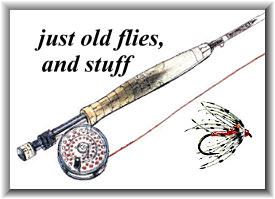
Welcome to 'just old flies,' a section of methods and flies that used-to-be. These flies were tied with the only materials available. Long before the advent of 'modern' tying materials, they were created and improved upon at a far slower pace than today's modern counterparts; limited by materials available and the tiers imagination.
Once long gone, there existed a 'fraternity' of anglers who felt an obligation to use only the 'standard' patterns of the day. We hope to bring a bit of nostalgia to these pages and to you. And sometimes what you find here will not always be about fishing. Perhaps you will enjoy them. Perhaps you will fish the flies. Perhaps?
CLARET SCOTT
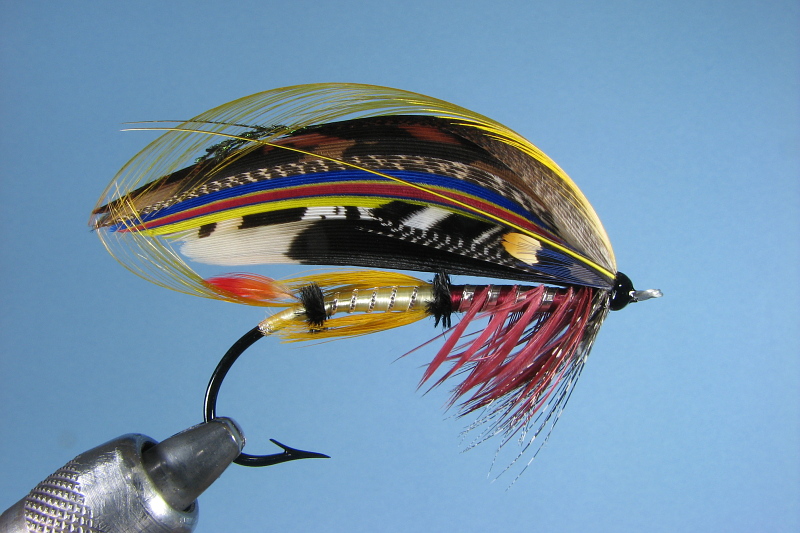
I've found only three references to this fly, a recipe in Hardy's Salmon Fishing, another mention in an article written for Bailey's magazine some time between 1860 and 1910 and a third listing in The Catalogue of Hardy's Angling Specialties, as a good fly for the Forth and Teith. The fly is called either the Claret Scott or the Claret Jock Scott depending on the publication. It's interesting to note that another article in Bailey's magazine details sport fishing for whales. Sadly, it never really caught on, the author surmising that gentlemen really couldn't subject themselves to the rigors of whaling, much less the smell on board the ship. There are no flies for whales anyway, so we'll have to confine ourselves to the comments below regarding the use of the Claret Scott for salmon fishing on Lough Corrib from an article titled "Angling in Ireland":
Lough Corrib offers the additional advantages of a good supply of salmon. They run up the Galway River in May and tune, and during the height of the green drake season they take the dap. They are found principally in Oughterard Bay, and three or four in a day is not an unusual number. They will also take artificial flies, a medium-sized claret Jock Scott, a black body with claret hackle and mixed wing, and the orange grouse. A glance at the celebrated Galway river during the early summer months, shows the quantity of salmon that are waiting to run up, and the greater number reach the lake before the end of the season. They do not take the fly well after July, but many are caught by trolling up to September. Although there is a big run of white trout in the river, very few of them are caught in Corrib; the supposition is that they spawn in some of the small tributaries, and do not reach the angling ground. The Owenriff and other rivers in the neighbourhood yield a good many salmon to anglers during or after spate.
The reference to the Claret Scott found in Hardy's Salmon Fishing specifies the dressing. I'll give that at the very end of this piece, after another article from Bailey's that I hope will be of interest.
The article is entitled "The Art of Fly-tying", wherein an author referred to only as "Corrigeen" gives instructions on tying a salmon fly. Note that the title refers to "Fly-tying," not fly dressing, even though Bailey's was published in London. I've been led to believe on more than one occassion that only fly "dressing" took place in England, never fly "tying". This article would tend to belie that assumption. Also be aware that the fly in this article is tied in hand. The author states: The best salmon-fly tiers I know never use a vice... Even if you feel the need to use a vise, as I do every so often (for instance, whenever I tie a fly), this article will give some real insights into how flies were done in the early 20th century, 1907 in this case. There are actual photos with this article, not just illustrations. Here it is in its entirety:
[Article Beginning]
The Art of Fly-tying by Corrigeen
To know how to tie a fly ought to be the ambition of every angler, and by a master of the craft the best results of river and lake are achieved. From an economical point of view, especially to the salmon-fisher, considerable expense is saved, and in emergency a knowledge of the art will save both time and disappointment.
Anglers not infrequently find themselves a long cry from a tackle-shop. A small box of furs, feathers, and flosses does not take up much space in one's kit. Like the sportsman twenty miles from anywhere and the wrong cartridges, the Waltonian may find his stock of flies neither the right size nor pattern. The flytier, under such circumstances, will have an advantage over his brother who is dependent upon the professional for this part of his outfit. On one occasion I found myself in the wilds of Donegal, five and twenty miles from a railway station. A state of consternation prevailed amongst the anglers who, like myself, had sought out this remote region in quest of white trout. The loughs had run very low, and the stock of flies contained nothing small enough to cope with the abnormal state of the water. A roughbodied pattern, locally called " old leather," was the favourite with the trout. Letters had been sent and telegrams despatched, but none of the tackle-makers could supply the desired article. Fortunately I had both small hooks and the right materials, and half a day's work enabled me to supply myself and share with my brothers in distress.
An amateur fly-tier cultivates simplicity. It is by no means making a virtue out of necessity to add. that this is an advantage. Elaborately dressed flies are by no means the best killers. Overcolouring is a common fault. It is necessary to bring down the mighty from his seat to make him practical, and I have known many a gaudy fly to be denuded of much of its court dress before proffering it to a salmon. The artistic is not always the artful, and in this, as in a great many things,summa ars est celare artcm.
But the most stimulating consideration to the would-be amateur tier is the pleasure of killing a salmon on his own fly. We are all proud of our own children, even when their constitution consists of nothing more than fur and feather. They are to be trusted, too, for the gut loops have been carefully selected and tested, and tied to the shank with the greatest care. Flies tied by the gross contain many faulty specimens, as most anglers have learned to their cost; the commonest of all is defective gut loops, which the innate conservativism of local tiers prefer to the eyed-hook pattern, which in small flies at least is preferable.
Most anglers eschew fly-tying under the conviction that the art is impossible to achieve. I do not say that it is easy, but it is by no means impossible. Given ordinary deftness of fingers, and the usual amount of patience with which all anglers are supposed to be gifted, the difficulties will be surmounted in the majority of cases. Practice, too, will work miracles, and it is encouraging to notice how each attempt will be an improvement upon the last, until there will not be much to choose between the work of the amateur and the professional.
Tying depends upon a few definite instructions, which it is the object of this article to supply. They are accompanied by photographic examples of each stage in the process, from the unmounted hook to the fully equipped fly. Every tier has his own particular method, and to him it is naturally the best. My experience covers twenty years, and the flies I have made have a fair record behind them. There is no secret in their manufacture beyond what is stated in these pages.
The tier's outfit is simple and inexpensive. It can be purchased for a few shillings. A pair of angler's scissors, watchmaker's tweezers, and hackle pliers, are all that are necessary as far as tools are concerned. For small trout-flies, vices and other implements are required. The best salmon-fly tiers I know never use a vice, and as the examples I give concern large flies, I confine myself to the essential. The principle of tying is the same whether the flies be small or large. The hackles, fur, twist, &c., involve a larger outlay. Golden pheasant crests, Indian crow, jungle cock, and suchlike, are expensive, but when a stock is laid in the number of flies that can be made makes the cost per pattern very slight.
The number of elements in a salmon fly amount to from fifteen to twenty-five ; all these from first to last are tied with a single piece of well-waxed silk, varying in thickness according to the size of the hook. If the thread breaks, it must not be knotted, but reattached by one or two coils, catching the end underneath on the shank of the hook. Constant rewaxing is important, especially where any of the elements, such as twist hackle or wing, are finished off. A little turpentine or methylated spirit should be used to keep the fingers free from wax, as the delicate flosses and feathers are easily stained ; inattention to this precaution will spoil one's best work. I have chosen the simplest flies as examples to tie for an obvious reason; more complicated patterns may be tried when the beginner has mastered the principles upon which these are built up.
The orange goshawk is the first example. In Galway it is called the goldfinch, in other places the sun fly.
The hook is held between the finger and thumb of the left hand, point downwards, the waxed thread is attached to the bare shank close to the end, but leaving sufficient room for the floss, twist, hackle, and wings, which are finished off at this point. In attaching, the end of the waxed thread must be caught by one or two close coils underneath and drawn tight. If it is an eyed hook, the thread is attached opposite to the point of the hook. If a gut loop is used, the gut should be soaked for a few minutes in warm water, then bent to form the loop, which projects a little below the end of the shank where it is to be attached to the casting line. The two loose ends of the gut are laid along the top of the shank and carried up towards the finger and thumb where the hook is held. The thread is now coiled upwards closely, binding on the gut until the point of the hook obstructs the coiling. This is the point to stop, and the gut ends are cut off close to the wrapping (Plate A, 1). To keep the thread tight, coil it four or five times down the shank; the wax will keep it in this position until it is needed for the next element. (Plate A, 2, shows this method of temporary fastening).
Tag.-Take an inch or so of fine round silver twist, lay it on the near side of the hook where the gut has been cut off, indenting one end with the thumb-nail where it is about to be fastened. Leave sufficient space for it to be coiled round three times. Now unwind the thread from the temporary fastening, and, holding it tight, coil it twice round the twist where it has been indented, get the thread out of the way by coiling it down the shank again, catch the end of the twist and roll it three times downwards as closely as possible, place the third finger of the left hand on it to keep it from uncoiling, and with the right hand catch the waste end of the twist in the pliers and let them swing loose, their weight will keep the twist from uncoiling. The right hand is now free to bring back the thread and fasten the twist on with a couple of tight coils. Temporary fastening again. Cut off the surplus twist close to the fastening. It may now be said once for all that, whenever any part is attached by the thread, the temporary fastening follows. This part of the process it will be unnecessary to repeat. Take about two inches of light blue silk floss, straighten it out, and divide it with the point of the scissors. Take one of the parts proportionate in thickness to the size of the fly, and fasten it to the side of the hook where the twist has been attached, coil it two or three times below the twist and refasten, taking care that in this and all subsequent processes the thread wrapping is covered over. Cut off the surplus floss.
Butt.-The butt is made of a single black ostrich feather. By holding it up it will be found that the fibres branch from the central rib in a V-shape. The feathers must be placed so that they branch away from the shank of the hook, and lie upwards. Strip off some of the fibres from the butt of the feather and attach it by the thread to the side of the hook. Catch the feather by the top in the pliers, and, passing the first finger through the pliers-ring, coil the feather on the hook a few times by means of the pliers; let the pliers swing, and fasten on with the thread, cutting off the waste portion.
Tail.-The tail consists of a golden pheasant crest. The rudimentary is torn off and part of the white portion of the feather near the butt. The crest is tied on the top of the shank, not on the side, as in the case of other elements. It must be attached close to "butt" so as to lean against it, and curving upwards; a glance at the feather will show the correct side by which it is to be tied on (Plate B, 1).
Body.-The body consists of a piece of orange floss silk, about three times the length of the hook. Unless the fly is very large, the silk must be divided and one portion used. Before attaching it to the hook, preparation must be made for the twist that is to be coiled down the body, and also the body hackle. The steps to be taken are as follows:
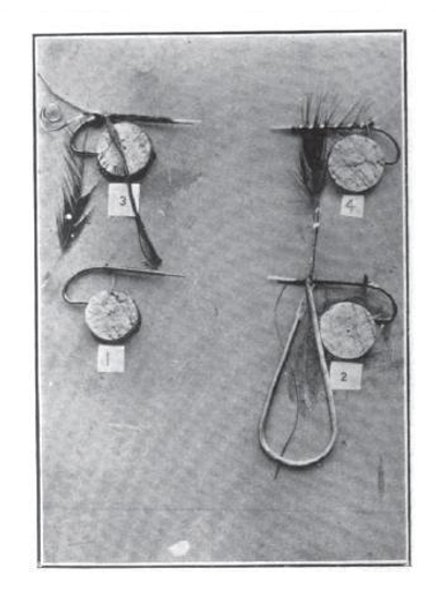
A.-(1) Goat loop lied. (2) Tag and hull. (3) Twist, hackle and body ready for coiling. (4) Hackle, with pliers swinging.
(1) Take a piece of broad, flat silver twist, about twice the length of the hook, indent the end with the finger-nail, and fasten the twist to the near side of the hook and parallel to it (so that the other end of the twist inclines from the shank), and as close to the "tail " fastening as possible. (2) Take a dyed golden olive cock hackle, cut a small notch in the fibre near the top of the feather, where it is to be fastened on. Strip off with the fingers about one-third of the fibres of the other side of the hackle so the spine is quite bare. Fasten the feather where it has been notched over the twist fastening, taking care that the stripped side lies close to the hook. The hackle must incline in the same direction as the twist. We have now two elements fastened almost on top of each other, but so neatly as not to form a bulge.
Just below these the silk floss to form the body is attached. In this case, however, the tie leaves the end of the floss loose, which stretches down close to the loop. The tying thread is coiled around it and fastens it, and is now in the right position to secure the body floss that is about to follow it. This extension down the hook is necessary for padding, and gives the effect of a fuller body. The waste ends of the twist and hackle are cropped close (Plate B, 2).
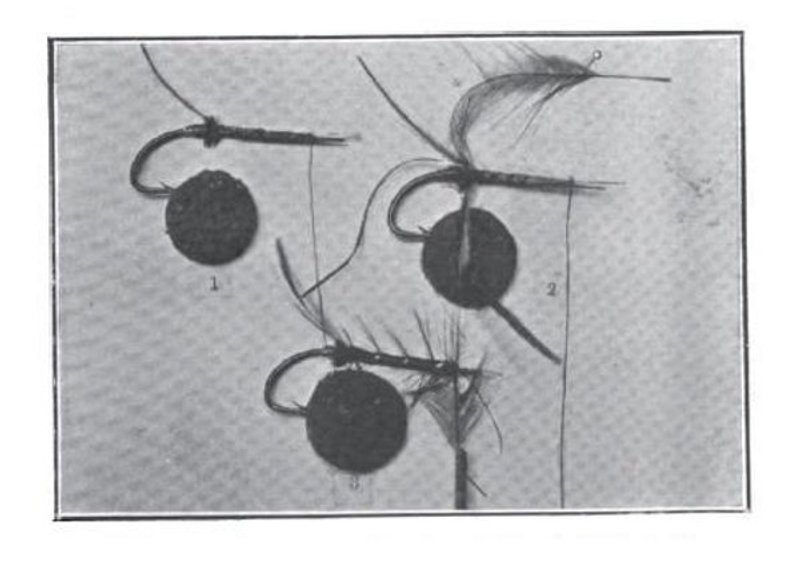
B.-(l) Tag, tail and butt. (2) Twist hackle and body. (3) Hackle in pliers.
A spare finger of the left hand must be now used to keep the loose parts out of the way whilst the body is being formed as follows: The extreme end of the floss is taken between the fingers of the right hand and the rolling on begins. To effect a sheen the hold must not be relaxed until the last coil is made. In this way all the threads of the floss have the same tension in them, and this is the secret of the sheen. The floss should be tightly rolled on throughout. The first coil is made close to the "butt". There are a number of thread wrappings of the different parts that have been affixed at that point, the floss now hides them. Care must be taken not to carry the body down too low on the shank, space must be left for the wings and shoulder hackle. The last coil being made, the floss is fastened by the thread and the waste cut off.
The silver twist follows next. It is a matter of taste as to the number of coils-four to six are usual; the twist needs careful fixing and the thread should be well waxed at this point, for its responsibility is growing greater every moment now. The body hackle follows the twist, the extreme point is caught in the pliers, and rolled on with the weight of the tool to keep it in its place. The hook is twisted round, and care must be taken that the fibres of the hackle shape upwards as everything else does. It follows the line of the twist very close to and above it, until three parts of the body are covered, then the coils become closer, and a bushiness is effected at the finish. Let the pliers still hold it whilst it is firmly fastened to the shank by the waxed thread. The remainder is cut off. Plate B,3.
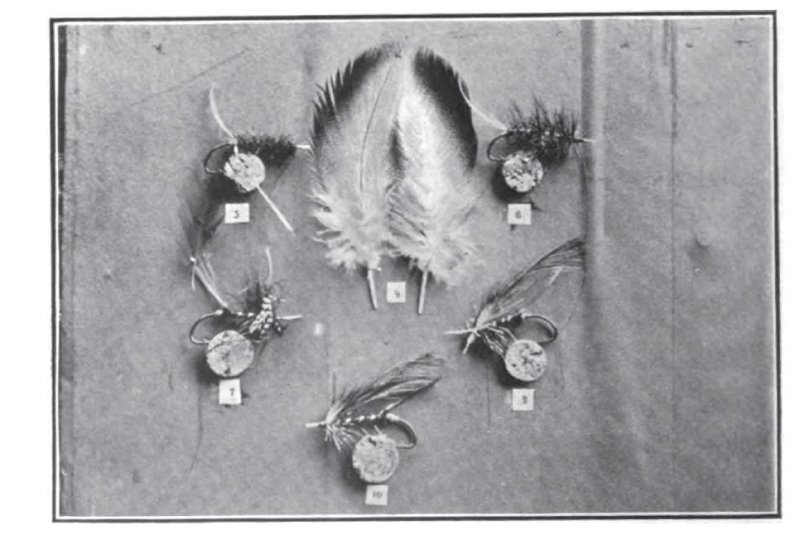
C.-(5) Rough body ready to be picked out. (6) Picked out. (7) Hackle ready to be rolled on. (8) Rolled on and wings partly lied. (9) Right and left mallard feathers. (10) Wings, tied and trimmed.
Shoulder Hackle.- This is composed of a feather from a blue Jay's left wing, and is prepared as follows : tear away the plain side on spine, leaving the blue part intact, except where a notch is cut close to the top, where the hackle is to be tied on. Place the feather on the bench and flatten out the quill with the back of a knife, or some other flat instrument ; stretch the feather along the first finger and slit it down with the scissors, removing all the pith. The object is to leave as little of the quill as possible, so that the hackle will be pliable enough to be wound round the hook. Tie on the feather to the shank, and catching the quill end in the pliers, roll it on close to the fastening of the "body hackle," taking care that the fibers lie in the same direction as the fibres of the golden olive. It must be rolled closely and evenly so as to present a bushy appearance. Let the pliers swing and finish it off with the thread, cutting away the surplus. (Plate C, 7, shows the shoulder hackle tied on in preparation for being rolled on.)
Wings.-When the shoulder hackle is in its place there must still be sufficient space on the shank to take the wings. Plate B 1, shows this. The Goshawk wings consist of six golden pheasant crests, three rights and three lefts. There is very little difference between them, but there is a difference, and the feathers will lie all the better if this point is studied. Tear off the rudimentary feathers.
This is the easiest of wings to tie, as the feathers are stiff and will shake into their places with a little care. A right and left are taken and one placed on each side of the shank and gently pulled into position by the thread -one at a time, of course. Two more are treated in the same way above those affixed, and so on until the six crests become a unit, and comprise the wings. None of the feathers must be allowed to straggle, and with a little practice this can be avoided. Fasten firmly with the thread and cut away loose ends.
Horns.-A strand of macaw on either side, which can be easily attached.
Head.-Take an ostrich feather and roll it on in the way described for affixing the " butt." A few neat rolls of thread well waxed and secured with a knot which is known as the " whip finish" completes the fly. This part is treated with anglers' varnish, one coat allowed to dry before another is applied.
THE ORANGE GROUSE FLY.
As this is an all-round standard fly for both salmon and trout, I have selected it for the second pattern to be tied.
It differs from the Orange Goshawk in the body hackle and wings only. The tag, butt and body are similar, and are tied in the manner already described.
The body hackle consists of an Irish grouse feather, which is prepared by stripping off the fibres on the left side half way down. The fibres do not pull off one by one like the cock hackle; a film of the quill comes away with them, and when the required length is peeled off, it must be cut with the scissors. When the hackle is rolled on it must be trimmed in a slant from the bushy part down to the " butt" and on a level with it. This can be effected by a single snip of the scissors.
Wings.-The wings are mixed and contain so many parts that practice alone will bring proficiency.
Two toucan breast feathers are tied on the upper part of the shank, as close to each other as possible; if they slip to either side they straggle. Two strands of bustard feathers are tied on the right and left side of shank, but not too far down; one part is tied where the other leaves off. Two strands from the right and left spine of the golden pheasant tail follow the bustard on the same principle. Two strands (right and left feathers) of teal come next. The top feathers consist of bronze mallard, a right and left. The strands must be deep enough to practically cover at each side the parts already affixed; the right and left join on the upper part of the shank and look like one when properly fixed. Horns and head are tied as in previous pattern. Plate C, 9, shows right and left mallard feathers.
ROUGH-BODIED FLY.
The only part needing detailed description is the body, which consists of dyed seal fur, or similar material. Preparation having been made for twist and body hackle, the tying thread which remains near the butt is drawn straight and a small portion of the fur is teased out and wrapped round the thread loosely, then the thread is twisted round and round so that the fur is coated by it. The process must be continued until the thread is embedded in the center of the fur and becomes a spine to it. Next roll the thread furred over down the shank as if it were floss to the required point, taking care that it is done evenly. If it has been evenly distributed on the thread when rolled together there will no undue lumpiness. The surplus fur must now be separated from the thread. It can be easily slipped down the thread and got out of the way by the finger and thumb. Fasten the body securely on the shank. If different coloured fur is used, as in the case of the Butcher fly, one part must be fastened off before the next is proceeded with, the second colour fixed at the point where the first leaves off, and in such a way as to hide the fastening. The twist is now rolled down over the fur body and fastened. The next step is to make the body like a hairy caterpillar. The process is simple; pick out the fur between the rolls of twist with a pin, taking care not to dig too deep, and disturb the thread. Trim off any unduly long hairs.
SILVER-BODIED FLY.
When the hackle and twist are prepared as previously explained, a piece of floss silk to cover the body for padding follows. Then a long coil of plain broad tinsel is aff1xed, the floss is rolled down the shank and fastened, and the tinsel is treated in the same way, taking care that the padding does not show through the joints. The body twist that follows should be round instead of flat, next follow the body hackle, shoulder hackle, and wings.
[Article End]
Claret Scott (per Hardy)
Tag Silver twist and yellow floss silk
Tail: A topping and Indian crow
Butt: Black ostrich herl
Body:In two equal halves-first half, yellow floss butted with black herl, and veiled above and below with six or more toucan feathers; second half, claret floss.
Ribs: Fine oval silver tinsel over yellow floss, broader oval silver tinsel or flat silver tinsel and twist (in the large sizes) over the claret floss.
Hackle: A claret cock's hackle, wound over the claret floss
Throat Speckled Gallina
Wings A pair of black white-tipped Turkey tail strips (back to back); over these, but not entirely covering them, a "mixed" sheath of "married" strands of Peacock wing, yellow, claret, and blue Swan, Bustard, Florican, and Golden Pheasant tail; two or three strands of Peacock sword feather above; "married" narrow strips Teal and barred Summer Duck at the sides; brown Mallard over.
Sides: Jungle cock
Cheeks: Chatterer
Horns Blue and yellow macaw
Head Black ostrich herl
Credits: Salmon Fishing by John James Hardy; Angling in Ireland from Bailey's Magazine of sports and pastimes:Piscatoria:excerpts, volume 10 by Inishlyre; The Art of Fly-tying from Bailey's Magazine of sports and pastimes:Piscatoria:excerpts, volume 10 by Corrigeen; ~ ELA
[ HOME ]
[ Search ] [ Contact FAOL ] [ Media Kit ]